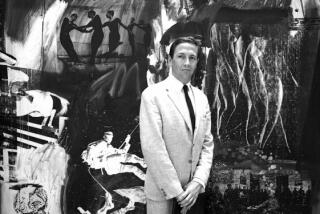Two Artists Bring U.S. to 22nd Bienal in Brazil : Exhibitions: The selection of Bettye Saar and John Outterbridge is unusual in two respects--they are from the West Coast and they are African American.
- Share via
SAO PAULO, Brazil — Exhibitions of two Los Angeles artists--Bettye Saar of Pasadena and John Outterbridge, former director of the Watts Tower Art Center--are representing the United States this year in the 22nd Bienal, a biannual exhibition that this year features work by 206 artists from a record 71 countries.
Stretched across 275,000 square feet and including 1,000 works, the Bienal is expected to draw more than 2 million artists, curators, collectors and other visitors from throughout the world.
Saar, 67, and Outterbridge, 61, are recognized for their assemblage work, created mainly of found or discarded material woven into poignant, evocative sculpture.
Though both artists are well-known in the United States, their presence here, supported by the U.S. Information Agency and Arts America, the National Endowment for the Arts and private foundations, represents something of a departure for the U.S., whose international appearances often are dominated by East Coast artists.
Saar and Outterbridge are not the first African American artists to represent America at the Bienal; Chicago sculptor Martin Puryear exhibited here in 1989. Still, Lizzetta LeFalle-Collins--an independent curator who proposed the two artists--said the selection of Outterbridge and Saar is significant for its recognition of African American work.
“There’s a way that ‘internationalism’ has been defined that doesn’t include the aesthetic judgments of people of color,” said LeFalle-Collins, who moved to Oakland two years ago from Los Angeles, where she served for six years as a curator at the California Afro-American Museum, the site of a major solo of Outterbridge’s work last year.
“People follow things that were originated in Europe and by European Americans, and much of it becomes copy work. They become the ‘aesthetic markers.’ What makes Bettye and John different is that they derive their art from these other sources that, over the years, have been deemed not to be that important.”
Works by other American artists, notably Robert Rauschenberg, are also on display here under a separate invitation of the Bienal. The two-month Bienal also features artists from throughout Europe, Asia and Latin America.
Saar’s work incorporates her interest in mysticism and the occult, deepened with studies in phrenology, palmistry, voodoo and shamanism. “Mojotech,” for instance, combines computer chips and wires with candles and hearts, suggestive of the connection between science and indigenous belief systems. “Sanctuary,” created for the Bienal, includes a life-sized canoe, doll-size chairs, lights, figurines and wax moldings of human body parts to “talk about the boat people, the Haitians, the Chinese, the Vietnamese, all of them.”
Outterbridge uses containers, cloth, rags and discarded metal in his works. His room-sized “Lie Lye Soap Conference With Seven Scarecrows” includes rags, sticks, gourds, washtubs and bricks to create scarecrow figures, clotheslines and a laundry setting that recalls the folk heritage of his youth.
Both artists’ works will remain on view here until mid-December; in February, they move to a biannual exhibition in Johannesburg, South Africa.
More to Read
The biggest entertainment stories
Get our big stories about Hollywood, film, television, music, arts, culture and more right in your inbox as soon as they publish.
You may occasionally receive promotional content from the Los Angeles Times.










